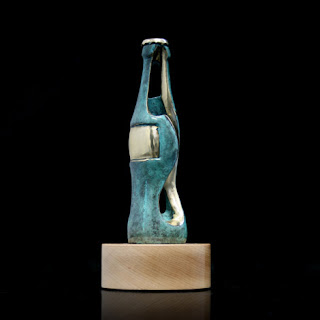Waterjet Cutting
A waterjet cutter can slice through a range of materials using a concentrated jet of water and abrasive material at high velocity and pressure. It seems unbelievable that water can cut through steel, but as the video below explains, a waterjet cutter concentrates the power of a waterfall into a point in the same way as a laser concentrates light.
Waterjet cutting is ideal for Gaudio as its flexibility allows us to do one-off commissions or large batches on a range of materials including marble, metals, glass and wood. The 2mm jet allows us to cut extremely complex shapes to high precision, and our state-of-the art machine even allows us to cut chamfers and angles.
CNC Machining
Where an award is too complex to be cut with a waterjet, we can use CNC machining. CNC allows us to profile complex 3D shapes from metal using CAD models created by our design team. Our CNC milling machine uses a range of cutting heads spinning at high speed to create various types of cuts and finishes at various angles into a block of aluminium, as demonstrated in the video below.
CNC machining is slower than waterjet, and therefore more expensive, but it is capable of far more complex shapes. The surface finish is also much better, so only a light polish is required to complete the award.
Rapid Prototyping/3D Printing
Huge amounts of money are currently being invested into this fast moving industry as everyone is predicting that 3D printing is about to take off in a big way. 3D printers used to be hugely expensive and require very skilled technicians, but “home” versions are now starting to develop which make things much easier, as the man in the video below very excitedly explains.
At Gaudio we have used SLS 3D printing on several occasions and we have a network of suppliers with various machines capable of different results. The great thing about these machines is that we can give our suppliers the 3D CAD files that we have created in the studio and we know that the finished article will be an exact copy.
3D printing is great for very complicated 3D designs with a low quantity. One of our favourite examples is the FIBA Basketball awards, which we manufactured using SLS 3D printing, plating with nickel and added an engraved acrylic ball and hand painted detailing. Because the design of these awards changes every year, it was not worth investing in a sculpted model and cast, so SLS made perfect sense. 3D printing is ideal for small batches as the set-up costs are often lower than sculpting from clay and casting. Because the awards are printed one at a time, there isn’t usually a cost saving as the quantity increases, so with larger orders casting becomes more cost effective as one mould can be used multiple times.
Sculpting & Casting
At one end of the scale we have the very modern, technology driven 3D printing, and at the other end we have the highly skilled centuries old tradition of hand sculpting. Because of the wide range of awards that we produce, we have to be knowledgeable on both processes and everything in between. Sculpting and casting is ideal for 3D forms, particularly human forms and organic shapes.
Our supplier network consists of several highly skilled sculptors, each with their own specialities. The client will be heavily involved in the sculpting process to ensure that the model is exactly to their specifications. Once the model is complete, we can then create a mould. From the mould we can recreate the award in several materials including resin and bronze. These types of awards have a high setup cost because of the highly skilled labour involved at the beginning, but once the mould is created it can be used for several years, meaning that each unit is actually relatively inexpensive.
Encapsulation
Encapsulated awards are traditionally used in the finance sector, where they are referred to as Tombstones. The process involves placing an object or print between two sheets of acrylic (usually clear) and heating the acrylic until it melts and bonds as one piece. The result is that the print or object is suspended inside the acrylic. Gaudio have used this process extensively in the past to produce some really creative results.
Laser Cutting/Engraving
Our laser cutting and engraving machines are always busy, so much so that we have recently invested in another state-of-the-art machine. The versatile machines are used for profiling acrylic, cutting acrylic detail and engraving, meaning that most of our awards pass through a laser at some point. The quick setup and speedy cutting times makes it a very cost effective process.
Printing
Gaudio have led the industry with the introduction of digital printing. We can print full colour onto acrylic, metal, wood and even marble. This led to a dramatic increase in the options available to us and our design team have really got creative with it. For our clients, the best thing is the ability to print full colour logos, complete with gradients and transparencies for the same price as mono-tone engraving. Unlike screen printing, we do not charge per colour used, so it is far more cost effective.
If you would like to find out more about any of our processes, please give our friendly team a call on 01242 232 383, or why not take advantage of our free design service?












This obliges an extraordinary arrangement of aptitude, learning, background and flexible hardware. We attempt to make however much as could be precision machining expected in our Gloucestershire producing office, yet we likewise utilise our quite close system of master suppliers for methodologies we don't have in-house.
ReplyDelete